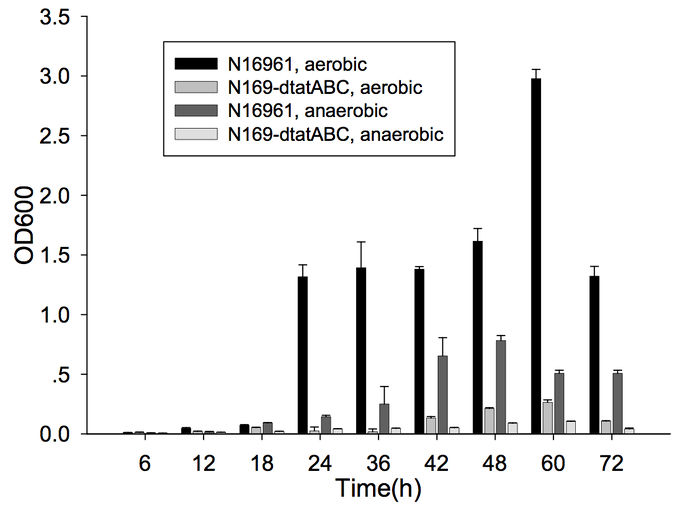Vibrio cholerae pathogenesis: Difference between revisions
No edit summary |
No edit summary |
||
| Line 6: | Line 6: | ||
[[File:Zhang_2009.jpg|upright=2.25|thumb|right||<b>Figure 1.</b> Biofilm growth of <i>V. cholerae</i> was measured using absorbance at 595 nm. Strains tested included wild type <i>V. cholerae</i> in aerobic and anaerobic conditions (the black and dark gray bars, respectively) and <i>tatABC</i> deletion mutants in aerobic and anaerobic conditions (the medium gray and light gray bars, respectively. To get measurements, overnight cultures were diluted two times and put into a 96-well cell culture plate. The plate cultures were grown at 37 °C under aerobic and anaerobic conditions for 6 to 72 hours. Biofilm growth was quantified by measuring absorbance at 595 nm of bacteria adherent to the plate stained with crystal violet. Each bar represents the average of 21 replicates. Data from Dr. Lijuan Zhang, of the Chinese Center for Disease Control and Prevention.<sup>[Zhang 2009]</sup>]] | [[File:Zhang_2009.jpg|upright=2.25|thumb|right||<b>Figure 1.</b> Biofilm growth of <i>V. cholerae</i> was measured using absorbance at 595 nm. Strains tested included wild type <i>V. cholerae</i> in aerobic and anaerobic conditions (the black and dark gray bars, respectively) and <i>tatABC</i> deletion mutants in aerobic and anaerobic conditions (the medium gray and light gray bars, respectively. To get measurements, overnight cultures were diluted two times and put into a 96-well cell culture plate. The plate cultures were grown at 37 °C under aerobic and anaerobic conditions for 6 to 72 hours. Biofilm growth was quantified by measuring absorbance at 595 nm of bacteria adherent to the plate stained with crystal violet. Each bar represents the average of 21 replicates. Data from Dr. Lijuan Zhang, of the Chinese Center for Disease Control and Prevention.<sup>[Zhang 2009]</sup>]] | ||
===Biofilms=== | ===Biofilms=== | ||
===Toxin-Coregulating Pilus=== | ===Toxin-Coregulating Pilus=== | ||
==Cholera Toxin== | ==Cholera Toxin== | ||
===Quorum Sensing=== | |||
===CT Characteristics=== | |||
==ToxR and ToxT Regulon== | ==ToxR and ToxT Regulon== | ||
Revision as of 01:39, 23 March 2015
Vibrio cholerae is the causative agent of the diarrheal disease cholera. A disease affecting 2.8 million people per year and resulting in the deaths of 91,000, cholera is most common in areas with high population density and low sanitation quality.[1] [2] Not all V. cholerae are pathogenic: only two strains of serogroups O1 and O139 cause cholera.[1] Furthermore, it is considered a facultative human pathogen, as it primarily inhabits surface waters, as opposed to the small intestine.[3]
When entering and colonizing the human host, V. cholerae must endure changing environmental factors such as temperature, acidity, osmolarity, intestinal growth inhibitory substances, and immune system factors.[1] After sufficient colonization, an autoregulatory loop controlling ToxT, cholera toxin, and the toxin-coregulated pilus (TCP) results.[4] Understanding pathogenesis of V. cholerae requires the understanding of colonization and this loop.
Colonization of the Human Small Intestine

Biofilms
Toxin-Coregulating Pilus
Cholera Toxin
Quorum Sensing
CT Characteristics
ToxR and ToxT Regulon
References
[1] Reidl, J. and K.E. Klose, Vibrio cholerae and cholera: out of the water and into the host. Fems Microbiology Reviews, 2002. 26: p. 125-139.
[2] Ali, M., et al., The global burden of cholera. Bulletin of the World Health Organization, 2012. 90: p. 209-218.
[3] Sack, D.A., et al., Cholera. Lancet, 2004. 363: p. 223-233.
[4] Yu, R.R., and V.J. DiRita, Analysis of an autoregulatory loop controlling ToxT, cholera toxin, and toxin-coregulated pilus production in Vibrio cholerae. J. Baceriol, 1999. 181: p. 2584-2592.
Edited by Tina Solvik, a student of Suzanne Kern in BIOL168L (Microbiology) in The Keck Science Department of the Claremont Colleges Spring 2015.
